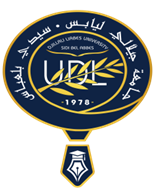- [ VRPG-Doc] Génie mécanique --- هندسة ميكانيكية
Permanent URI for this collection
Browse
Browsing - [ VRPG-Doc] Génie mécanique --- هندسة ميكانيكية by Author "BENAYAD Zouaoui"
Now showing 1 - 1 of 1
Results Per Page
Sort Options
- ItemNumerical Investigation of Cooling Electronics Components(2021-04-12) BENAYAD Zouaoui; Encadreur: LAOUEDJ Samir; Co-Encadreur: JUAN PEDRO SOLANOالملخص (بالعربية) : في الآونة الأخيرة، اجتذبت عملية تبريد المكونات الإلكترونية العديد من الباحثين، وقد تم عرض العديد من التقنيات لتحسين كفاءة التبريد ومعدل نقل الحرارة. واحدة من أكثر التقنيات فعالية هي إدخال نفاثة اصطناعية وتعديل السطح الساخن. في الدراسة الحالية، تم تعديل شكل السطح الساخن للمكونات الإلكترونية مع تعديل عدد فتحات خروج المبرد و كذلك شكل إشارة الحجاب الحاجز لتحسين النفاثة الاصطناعية. هذه التعديلات جديدة وقد تم تطبيقها لأول مرة و تم الحصول على كفاءة تحسين حراري جيدة جدًا بالنسبة للقنوات الصغيرة ذات التطبيقات النفاثة الاصطناعية. سمحت لنا هذه الدراسة بإجراء مقارنة كمية بين حالة أساسية بإشارة دورية وحالات معدلة. يتم حل التدفق غير المستقر ونقل الحرارة للنفاثة الاصطناعية ثنائية الأبعاد باستخدام برنامج fluent ANSYS ويتم اختيار نموذج K-ω (SST) لحساب اضطراب السوائل. أظهرت النتائج التي تم الحصول عليها زيادة في رقم النسلت بنحو%60 للحالة المعدلة مع نفاثتين اصطناعيتين مائلتين دات فتحات بانسداد متقارب وبمنحدر3 درجة و 10 ميكرومتر من تموج الجدار الساخن عند تغيير موضع التجاويف واضافة إشارة ثنائية الفترات مقارنة بالحالة الأساسية. ----------------------------------------------------------------------------------- Résumé (Français et/ou Anglais) : Recently, the cooling process for electronics components has attracted many researchers and several techniques for improving the cooling efficiency and heat transfer rate have been demonstrated. One of the best efficient techniques is the introduction of a synthetic jet and the modification of heating surface. In the present study, the form of heating surface, as well as the shape and number of orifices and the signal of the diaphragm has been modified to improve the synthetic jet. These modifications are novel and have been applied for the first time with very good thermal enhancement efficiency for microchannels with synthetic jets applications. This study allowed us to make a quantitative comparison between a basic case with a periodic signal and modified case. The unsteady flow and heat transfer for the two-dimensional synthetic jet are solved using ANSYS fluent code and k-ω (SST) model is selected to account for fluid turbulence. Obtained results showed a cooling improvement of about 60% for the modified case with two synthetic jets inclined with 3° and converged form of orifices and 10 µm of undulation heated wall when changing the position of the cavities so as to introduce a bi-periodic signalcompared with the basic case. ----------------------------------------------------------------------------------- Récemment, le processus de refroidissement des composants électroniques a attiré de nombreux chercheurs et plusieurs techniques permettant d'améliorer l'efficacité du refroidissement et le taux de transfert de chaleur ont été démontrées. L'une des techniques les plus efficaces est l'introduction d'un jet synthétique et la modification de la surface chauffante. Dans la présente étude, la forme de la surface chauffante ainsi la forme et le nombre d'orifices et le signal du diaphragme ont été modifiés pour améliorer le jet synthétique. Ces modifications sont nouvelles et ont été appliquées pour la première fois avec une très bonne efficacité d'amélioration thermique pour les micro-canaux avec des applications de jets synthétiques. Cette étude nous a permis de faire une comparaison quantitative entre un cas de base avec un signal périodique et des cas modifiés. L'écoulement instable et le transfert de chaleur pour le jet synthétique bidimensionnel sont résolus à l'aide du code fluide ANSYS et le modèle k-ω (SST) est sélectionné pour tenir compte de la turbulence des fluides. Les résultats obtenus ont montré une amélioration de refroidissement d'environ 60 % pour le cas modifié avec deux jets synthétiques inclinés avec 3° et forme convergente des orifices et 10 µm d'ondulation de la paroi chauffée quand on change la position des cavités ainsi introduire un signal bi-périodique par rapport au cas de base.
